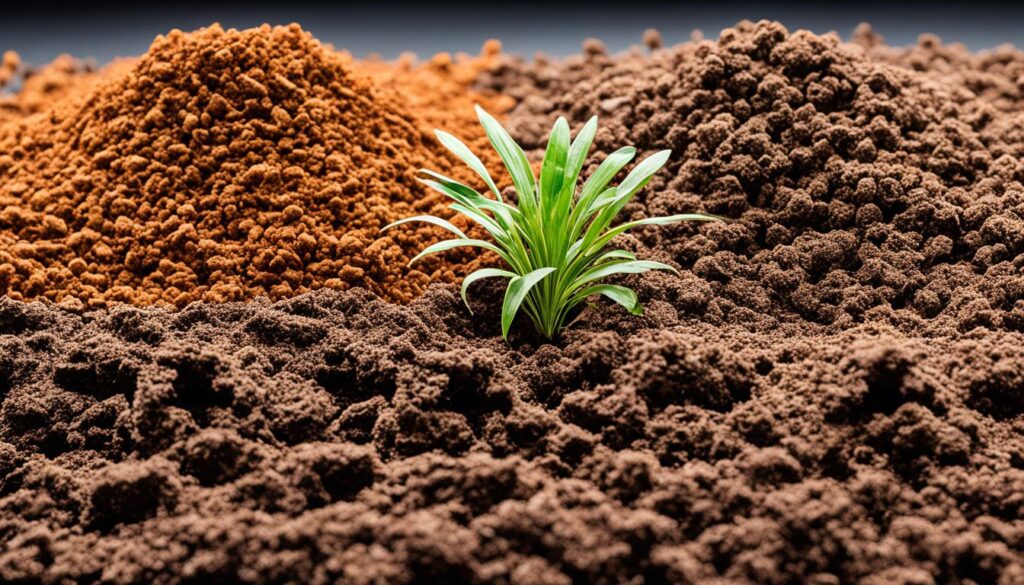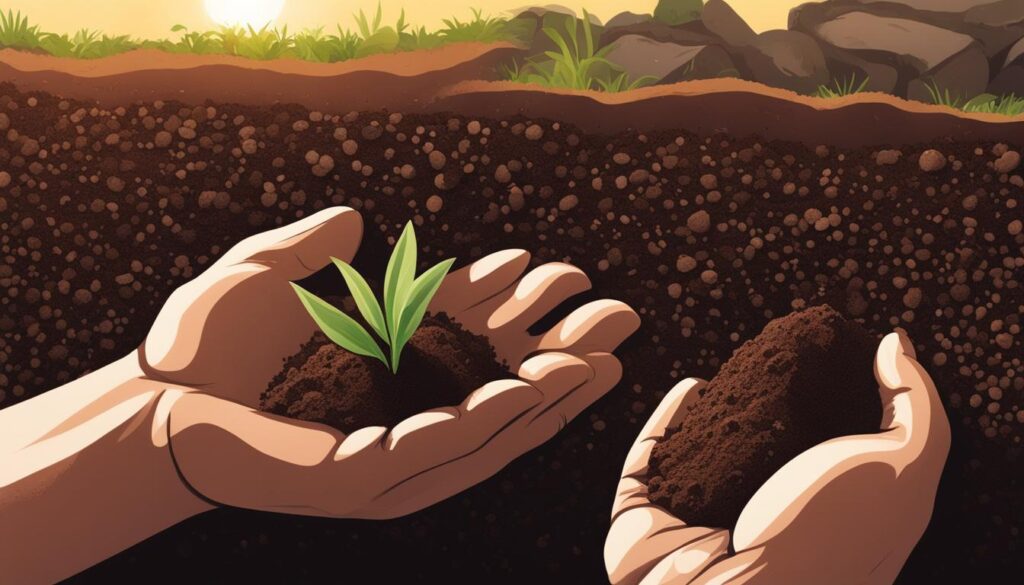Have you ever wondered how to make your own seed starting soil? With DIY seed starting mix, you can have full control over the ingredients and provide the perfect medium for your seedlings to thrive. But what exactly goes into making a seed starting mix, and why is it beneficial for your garden?
Many gardeners rely on store-bought potting soil for their seedlings, but making your own seed starting mix has numerous advantages. Not only can it save you money, but it also allows you to customize the mix to suit the specific needs of your plants. By creating a DIY seed starting mix, you’ll be giving your seeds the best chance at success.
Key Takeaways:
- Making your own seed starting mix provides control over the ingredients and customization for your plants.
- Different ingredients, such as coco coir and perlite, can be used to create a DIY seed starting mix.
- DIY seed starting mix is cost-effective and ensures optimal conditions for seed germination and growth.
- If you prefer not to make your own, commercial options are available with different textures and nutrient content.
- Choosing the right seed starting mix is essential for successful seedling development.
Understanding Seed Starting Mix
Seed starting mix, also known as seedling mix, is a soilless medium specifically designed for starting seeds. Unlike potting soil, seed starting mix is lighter, finer, and provides optimal conditions for seed germination.
Seed starting mix has several benefits that make it a popular choice for starting seeds:
- Free from soil-borne diseases and weed seeds: Seed starting mix is clean and safe, minimizing the risk of introducing harmful pathogens or weeds to your seedlings.
- Finer texture for easy seed germination: The fine texture of seed starting mix allows small seeds to push through easily and ensures proper root formation.
- Gentle start for seedlings: Seed starting mix is less nutrient-rich compared to potting soil. This is intentional as seedlings don’t require high levels of nutrients in the early stages of growth.
“Seed starting mix provides optimal conditions for seed germination and creates a clean and safe environment for your seedlings.”
Ingredients for DIY Seed Starting Mix
When creating your own seed starting mix, you have the option to choose between different ingredients. One key decision is whether to use coco coir or peat moss as the soil-less medium. Both options offer excellent moisture retention and drainage properties, but coco coir is often preferred due to its sustainable nature. For aeration and drainage, you can choose between perlite and vermiculite, both of which are lightweight and help prevent overwatering. Optional additives like worm castings can be included to provide additional nutrients to your seedlings. Worm castings not only improve the structure of the growing medium but also introduce beneficial microbes and increase oxygen levels, creating an optimal environment for seedling growth.
Here is a breakdown of each ingredient:
| Ingredient | Properties |
|---|---|
| Coco Coir | Sustainable, excellent moisture retention and drainage |
| Peat Moss | Good moisture retention and drainage |
| Perlite | Lightweight, prevents overwatering |
| Vermiculite | Lightweight, prevents overwatering |
| Worm Castings | Improves structure, introduces beneficial microbes, increases oxygen levels |
By selecting the right ingredients for your DIY seed starting mix, you can create a nurturing environment for your seedlings to thrive.

Making Your Own DIY Seed Starting Mix
Making your own DIY seed starting mix is a simple and cost-effective way to ensure the success of your seedlings. By preparing your own mix, you have full control over the ingredients used, allowing you to create a custom blend that meets the specific needs of your plants. Here is a basic DIY seedling mix recipe to get you started:
- Coco Coir or Peat Moss: Start with equal parts of either coco coir or peat moss. Both options provide excellent moisture retention and create a light, fluffy texture that promotes root development.
- Perlite: Add perlite, which serves as an aeration and drainage component. This lightweight material helps prevent waterlogging and keeps the mix well-aerated.
- Vermiculite: Include vermiculite, another material that aids in moisture retention and provides additional drainage. Vermiculite has excellent water-holding capacity, ensuring proper hydration for your seedlings.
- Worm Castings: For an extra boost of nutrients, consider adding a handful of worm castings to the mix. Worm castings enrich the soil with organic matter and beneficial microbes, providing a healthy environment for seedling growth.
Thoroughly mix all the ingredients until they are well combined. The resulting mixture should have a loose, crumbly texture and hold together when lightly squeezed. Avoid excess moisture that can lead to waterlogged conditions.
Pro Tip: To determine the right moisture level, take a small handful of the mix and squeeze it in your hand. It should hold its shape but not release excess water.
Once your DIY seed starting mix is ready, you can fill your seedling trays or pots with the mixture. Gently pat it down to create a flat and even surface. Now, it’s time to sow your seeds and provide them with the perfect environment for germination and growth.
Benefits of Making Your Own Seed Starting Mix
“Preparing your DIY seed starting mix offers several advantages. Firstly, it allows you to customize the blend based on your plants’ specific requirements. Secondly, by using high-quality ingredients, you can ensure that your seedlings receive optimal nutrition. Lastly, making your own mix saves money in the long run, as store-bought versions can be more expensive and may not always meet your expectations.” – Gardening Expert, Jane Smith

With this basic DIY seedling mix recipe, you can confidently start your seedlings and watch them thrive. Experiment with different ingredient ratios or incorporate additional amendments to tailor the mix to your gardening needs. By creating your own seed starting mix, you take a step toward self-sufficiency in your gardening journey.
Choosing the Right Seed Starting Mix
If you prefer not to make your own DIY seed starting mix, there are many commercial options available on the market. When choosing a seed starting mix, consider the texture, ingredients, and nutrient content. Look for a mix that has a fine texture to accommodate small seeds and promote strong root development. Check the ingredients to ensure they meet your preferences and gardening goals. Some mixes may include fertilizers or amendments, so decide whether you prefer an organic or synthetic option. Additionally, consider the brand’s reputation and customer reviews to make an informed decision.
Conclusion
Making your own seed starting mix provides numerous benefits that can enhance your gardening experience. The DIY approach allows you to save money while having full control over the ingredients used. By customizing the mix to suit your specific gardening needs, you can ensure that your seedlings have the perfect conditions to thrive and grow into healthy plants.
The main advantages of making your own seed starting mix include cost savings, ingredient control, and the ability to create a customized blend. By using a DIY seed starting mix, you can save money compared to purchasing commercial options. Additionally, you have the freedom to choose high-quality components such as coco coir or peat moss, perlite or vermiculite, and optional additives like worm castings. These ingredients contribute to a soilless medium that is lightweight and well-draining.
Whether you decide to make your own seed starting mix or opt for a commercial product, the key is to provide the ideal medium for your seedlings. Your chosen mix should be lightweight, offer excellent drainage, and meet the specific needs of your seeds and seedlings. By taking the time to create or select the right seed starting mix, you are setting the foundation for successful germination and healthy plant growth. Happy gardening!
FAQ
What is seed starting mix?
Seed starting mix, also known as seedling mix, is a soilless medium specifically designed for starting seeds. It provides optimal conditions for seed germination and is free from soil-borne diseases and weed seeds.
What are the benefits of using seed starting mix?
Seed starting mix is lighter and finer than potting soil, allowing for easier seed germination and root development. It also provides a clean and safe environment for seedlings, as it is free from contaminants, and it is less nutrient-rich, providing a gentle start for young plants.
What are the main ingredients for DIY seed starting mix?
The main ingredients for DIY seed starting mix include a soil-less medium (coco coir or peat moss), a material for aeration and drainage (perlite or vermiculite), and optional additives (such as worm castings) for added nutrients.
What is the basic recipe for DIY seed starting mix?
The basic recipe for DIY seed starting mix is equal parts coco coir or peat moss, perlite, and vermiculite. Optional additives like worm castings can also be included.
How do I make DIY seed starting mix?
To make DIY seed starting mix, thoroughly mix equal parts coco coir or peat moss, perlite, and vermiculite. Add a handful of worm castings for added nutrients. Moisten the mixture until it can form a loose ball without excess water. Fill your seedling trays or pots with the mixture and start sowing your seeds.
Can I purchase seed starting mix instead of making my own?
Yes, there are many commercial options available on the market. When choosing a seed starting mix, consider the texture, ingredients, nutrient content, and reviews of the product.
What should I consider when choosing seed starting mix?
When choosing seed starting mix, consider factors such as the texture, ingredients, nutrient content, and whether you prefer organic or synthetic options. Also, check the brand’s reputation and customer reviews.
What are the benefits of making my own seed starting mix?
Making your own seed starting mix allows you to save money, have control over the ingredients used, and customize the mix to suit your specific gardening needs.
